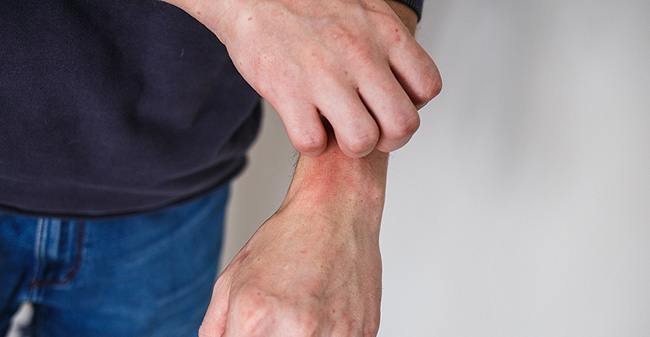
Cholestatic pruritus is caused by impaired bile flow, often associated with primary biliary cholangitis (PBC). PBC is a chronic liver disease that affects the bile ducts, leading to a buildup of bile in the liver. This condition can cause skin itching, which can be severe and distressing for patients. The itching is related to the accumulation of bile acids in the skin. Managing cholestatic pruritus in PBC involves addressing the underlying liver disease and using medications to alleviate itching. Treatments may include bile acid binders, antihistamines, and other drugs to help improve the patient's quality of life.
GLIMMER Clinical Trial
The GLIMMER study investigated the dose-response, efficacy, and safety of linerixibat, an inhibitor of the ileal bile acid transporter, for cholestatic pruritus associated with primary biliary cholangitis (PBC).The Phase 2b study included adults with PBC and moderate-to-severe pruritus, rated ≥4 on a 0-10 numerical rating scale (NRS). After four weeks of a single-blind placebo, patients with an NRS score ≥3 were randomly assigned (3:1) to receive either double-blind linerixibat or placebo for 12 weeks (until week 16), followed by a single-blind placebo (until week 20). The primary objective was to assess dose-related changes in the mean worst daily itch (MWDI) score.
Findings
Out of the 147 participants, some received a placebo. In contrast, others were given different doses of linerixibat: 20 mg once daily, 90 mg once daily, 180 mg once daily, 40 mg twice daily, or 90 mg twice daily. The linerixibat groups showed reductions of ≥2 points in the MWDI from baseline at week 16. However, the differences compared to the placebo group were not statistically significant in the primary intent-to-treat analysis.Yet, the change in monthly itch score over the treatment period (a Phase 3 endpoint) differed significantly between placebo and specific linerixibat doses: 180 mg once daily, 40 mg twice daily, and 90 mg twice daily. In the per-protocol population, a significant relationship between the total daily dose of linerixibat and the reduction in itch.
Adverse Effects
Adverse events were also assessed, and diarrhea was the most common side effect of linerixibat treatment. The incidence of diarrhea increased with higher doses, aligning with the mechanism of action.Conclusion
The GLIMMER study found that while linerixibat did not show significant differences versus placebo in the primary analysis, it did demonstrate a significant dose-dependent reduction in itch in the per-protocol population. A well-tolerated dose of linerixibat was identified for further investigation in Phase 3 trials as a potential treatment option for cholestatic pruritus in PBC patients. Further research is needed to validate its efficacy and safety for managing this challenging symptom in individuals with PBC.__________
Clinical Gastroenterology and Hepatology, Jul-23
ClinicalTrials.gov NCT02966834
About Liver Disease
Umbilical Cord Blood Stem Cell Transplantation in Decompensated Liver Cirrhosis
Can pomegranate Extract Improve Liver Health in Non-Alcoholic Fatty Liver Disease?
Diet High in Protein and Unsaturated Fatty Acids Benefits Liver Health in Older Adults
Hybrid Training System Shows Promise for Reducing Liver Stiffness in NAFLD Patients
Clinical Trial Investigates the Effect of Tucatinib in Patients with Liver Disease
Can Curcumin Decrease Liver Fat Content in Obese People?
Improving Liver Health with a Low Free Sugar Diet
New Drug Shows Efficacy in Slowing Down Fatty Liver Disease
Potential Drug Therapy for Liver Disease
Machine Mimicking Human Body can Preserve Donor Livers for a Week
ClinicalTrials.gov NCT02966834
About Liver Disease
Umbilical Cord Blood Stem Cell Transplantation in Decompensated Liver Cirrhosis
Can pomegranate Extract Improve Liver Health in Non-Alcoholic Fatty Liver Disease?
Diet High in Protein and Unsaturated Fatty Acids Benefits Liver Health in Older Adults
Hybrid Training System Shows Promise for Reducing Liver Stiffness in NAFLD Patients
Clinical Trial Investigates the Effect of Tucatinib in Patients with Liver Disease
Can Curcumin Decrease Liver Fat Content in Obese People?
Improving Liver Health with a Low Free Sugar Diet
New Drug Shows Efficacy in Slowing Down Fatty Liver Disease
Potential Drug Therapy for Liver Disease
Machine Mimicking Human Body can Preserve Donor Livers for a Week
